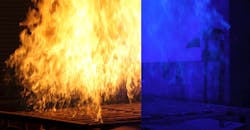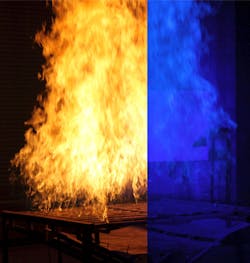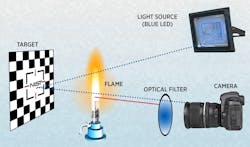Blue Light Lets Researchers See Through Fire
What’s the best way for scientists and engineers to see what is happening in the midst of a raging fire? According to researchers at the National Institute of Standards and Technology (NIST), ordinary blue light significantly improves a person’s ability to see objects engulfed by large, non-smoky natural gas fires. More importantly for scientists and engineers conducting laboratory fire studies and fire-resistance standards testing, blue-light imaging can be useful for obtaining visual data from test fires where high temperatures could disable or destroy conventional electrical and mechanical sensors.
For example, blue-light imaging can provide researchers data from digital image correlation (DIC), a technique that compares successive images of an object as it deforms under the influence of applied forces such as strain or heat. By precisely measuring the movement of individual pixels from one image to the next, scientists gain valuable insight about how materials respond over time.
However, using DIC presents a challenge: How do you get images with the level of clarity needed when there are bright, rapidly moving flames between the sample and the camera?
To improve the ability of researchers to “see” through fire, NIST has developed an imaging system using ordinary blue light to dramatically clear the picture. (Credit: National Fire Research Laboratory/NIST)
“Fire makes imaging in the visible spectrum difficult in three ways: with the signal being totally blocked by soot and smoke, obscured by the intensity of the light emitted by the flames, and distorted by the thermal gradients in the hot air that bend—or refract—light,” says structural engineer Matt Hoehler at NIST’s National Fire Research Lab.
To overcome these problems, the NIST team borrowed a trick from the glass and steel industry in which manufacturers monitor the physical characteristics of materials during production while they are still hot and glowing. They use blue-light lasers to contend with the red light given off by glowing hot materials that blinds their sensors.
Hoehler used commercially available and inexpensive blue LEDs with a narrow-spectrum wavelength around 450 nanometers for the experiment. Initially, the researchers placed a target object behind a gas-fueled test fire and illuminated it in three ways: by white light alone, by blue light directed through the flames, and by blue light with an optical filter placed in front of the camera. The third option proved best, reducing the observed intensity of the flame by a factor of 10,000-fold yielding highly detailed images.
However, just seeing the target wasn’t enough to make the blue-light method work for DIC analysis. The researchers also had to reduce image distortion caused by the flame refracting light, a problem akin to the “broken pencil” illusion seen when a pencil is placed in a glass of water.
The NIST narrow-spectrum illumination method lets researchers and cameras see through fire. Blue LED light is directed through a gas fire, reflects off the target behind the flames, and is captured by a camera after passing through an optical filter. This reduces the flame’s observed intensity by a factor of 10,000 and yields highly detailed images.
“Luckily, the behaviors we want DIC to reveal, such as strain and deformation in a heated steel beam, are slow relative to the flame-induced distortion,” Hoehler explains, “so we just need to acquire a lot of images, collect large amounts of data, and mathematically average the measurements to improve their accuracy.”
To validate the effectiveness of their imagining method, Hoehler and his team applied it to two large-scale tests. The first examined how fire bends steel beams and the other looked at what happens when partial combustion progressively chars a wooden panel. For both, the imaging was greatly improved.
“In fact, in the case of material charring, blue-light imaging may one day improve standard test methods,” Hoehler says. “Using blue light and optical filtering lets us see charring that is normally hidden behind the flames in a standard test. The clearer view, combined with digital imaging, improves the accuracy of measurements of the char location in time and space.”



